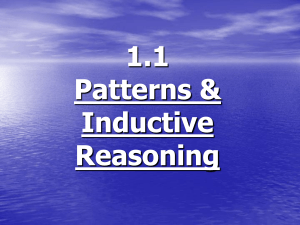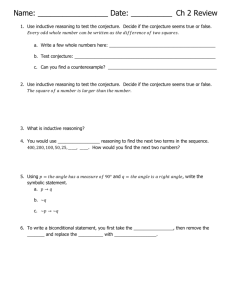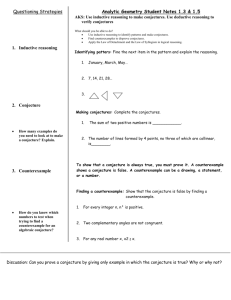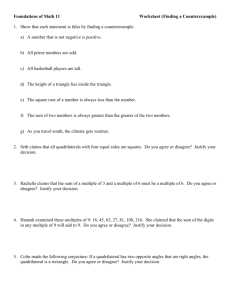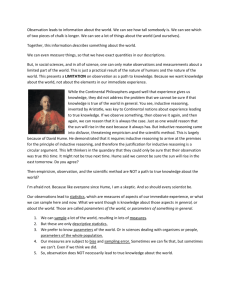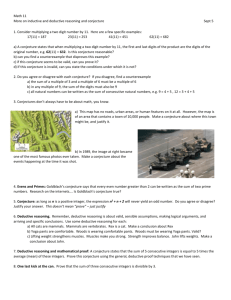Lecture
advertisement
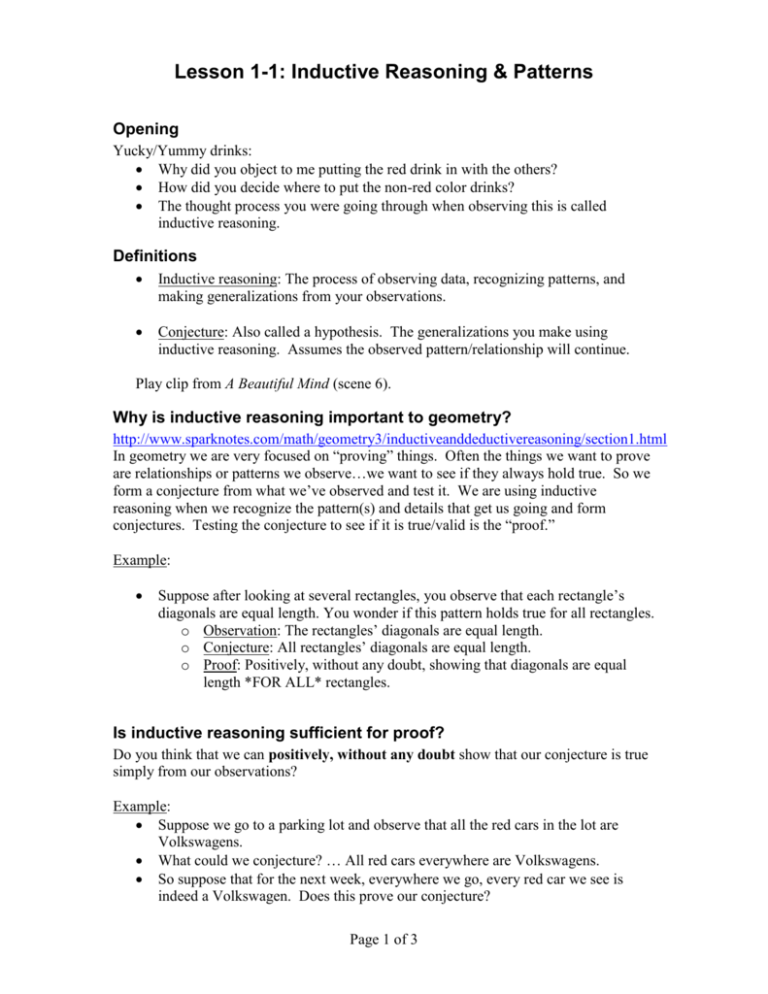
Lesson 1-1: Inductive Reasoning & Patterns Opening Yucky/Yummy drinks: Why did you object to me putting the red drink in with the others? How did you decide where to put the non-red color drinks? The thought process you were going through when observing this is called inductive reasoning. Definitions Inductive reasoning: The process of observing data, recognizing patterns, and making generalizations from your observations. Conjecture: Also called a hypothesis. The generalizations you make using inductive reasoning. Assumes the observed pattern/relationship will continue. Play clip from A Beautiful Mind (scene 6). Why is inductive reasoning important to geometry? http://www.sparknotes.com/math/geometry3/inductiveanddeductivereasoning/section1.html In geometry we are very focused on “proving” things. Often the things we want to prove are relationships or patterns we observe…we want to see if they always hold true. So we form a conjecture from what we’ve observed and test it. We are using inductive reasoning when we recognize the pattern(s) and details that get us going and form conjectures. Testing the conjecture to see if it is true/valid is the “proof.” Example: Suppose after looking at several rectangles, you observe that each rectangle’s diagonals are equal length. You wonder if this pattern holds true for all rectangles. o Observation: The rectangles’ diagonals are equal length. o Conjecture: All rectangles’ diagonals are equal length. o Proof: Positively, without any doubt, showing that diagonals are equal length *FOR ALL* rectangles. Is inductive reasoning sufficient for proof? Do you think that we can positively, without any doubt show that our conjecture is true simply from our observations? Example: Suppose we go to a parking lot and observe that all the red cars in the lot are Volkswagens. What could we conjecture? … All red cars everywhere are Volkswagens. So suppose that for the next week, everywhere we go, every red car we see is indeed a Volkswagen. Does this prove our conjecture? Page 1 of 3 Lesson 1-1: Inductive Reasoning & Patterns When we eventually discover a red car that is not a Volkswagen, our conjecture is shown to be false. This is called a counterexample. Definition Counterexample: A case that proves the conjecture wrong. It only takes one counterexample to disprove a conjecture. Deductive reasoning: Also called logical reasoning. Process of determining that if certain statements are accepted as true, then other statements can be shown to follow from them. Used to prove a conjecture to be true…geometric proofs. http://www.sparknotes.com/math/geometry3/inductiveanddeductivereasoning/section2.rhtml Inductive reasoning is used to form our conjecture. A single counterexample disproves our conjecture. Deductive reasoning is used to prove our conjecture. How do you reason inductively? Ask yourself: Are there any patterns? Is there a sequence? How are they similar? Anything the same in each? What do they have in common? How are they different? How are they changing? What is added each time? How do they relate to each other? Identify the important characteristics and build a table (based on your observations) showing how the related characteristics are changing each step. Make a conjecture about how things are changing. Use your conjecture to predict the next step. Check it. If false, you know your conjecture is wrong. If right, try a few more steps. You can improve your inductive reasoning ability and your ability to see patterns! Example from algebra Observe: 0·0=0 1·1=1 Conjecture: x·x=x Check next step: 2 · 2 = 4 → false! Counterexample that disproves our conjecture. Silly example Observe: 2, 4, 6, 8 … Page 2 of 3 Lesson 1-1: Inductive Reasoning & Patterns Conjecture: 10, 12 … Wrong! Who do we appreciate? ;) Yes, “10, 12…” is correct; the point is to be careful, be ready to think outside the box…there may be other ways of looking at things! Examples in geometry Example 1: Finding and using a pattern (p. 4) + Check Understanding 1 Example 2: Using inductive reasoning (p. 5) + Check Understanding 2 Example 3: Testing a conjecture (p. 5) + Check Understanding 3 Example 4: Real world connection (p. 6) + Check Understanding 4 Assign homework p. 6 #1-12, 17, 19-22, 25-29, 31-33, 36, 44, 52, 54 Page 3 of 3
